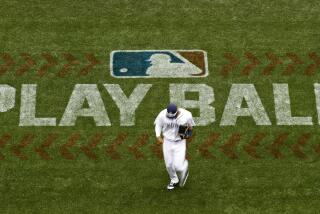Even the baseball card industry sees its future in the app store
In the top of the first inning of Major League Baseball’s All-Star Game this month, Chicago Cubs third baseman Kris Bryant clubbed a home run off the left field scoreboard at San Diego’s Petco Park.
Twenty minutes later, the moment had been memorialized with its own baseball card.
Welcome to the new world of card collecting, where your collection can be as large as your data plan.
Since 2012, Topps Inc. has launched seven free apps that let users collect and trade digital cards. As app store visits surge and hobby store visits decline, these programs have injected cash and interest into one of the last vestiges of print media to go digital.
Digital trading cards look a lot like their paper forebears: a photo on the front, stats on the back. Users open the apps to ogle their collections, make trades with other players, and get new cards by opening a limited number of free packs. Die-hards pay for additional packs, increasing their chances to land rarer cards that can be swapped for real-world money.
Aside from the nation’s pastime, Topps has apps for the NFL, soccer, the UFC and the WWE. It has also broached non-sports markets with trading card apps for “Star Wars” and “The Walking Dead.”
The privately held New York company would not discuss the profitability of its apps, but said physical sales currently outweigh digital sales. Its digital business, however, is rapidly growing.
Topps said its apps have been downloaded more than 9 million times. Kick, a soccer app, is its leader, with more than 4 million downloads. More than 600 million packs have been opened across its apps, with an increase of more than 50% in the past year.
According to AppAnnie, an app tracking service, five Topps apps have ranked among the top five most downloaded sports and entertainment apps; three have held the top spot at times.
The digital products have allowed Topps to build a business that is in many ways the opposite of its printed cards.
Paper cards take days to make, package and ship. They are generally released in sets just once or twice a year — and interest in them peaks around opening day.
With digital apps, it takes just minutes for Topps to release new cards after big plays, decisive victories or trades, or update existing cards with up-to-date statistics. And the company doesn’t have to worry about paper, ink, packaging or shipping.
But Jeremy Strauser, vice president and general manager of digital apps, cautioned that the digital business isn’t without costs.
“We have to create a software, an app, and make it work,” he said. “I wouldn’t say it’s cost-saving — I would say it’s a different kind of business.”
One cost is personnel. When Topps director of app production Chris Vaccaro started the job four years ago, five employees worked on its app division. Now there are more than 50.
“Every day I still wake up and can’t believe what we’re doing,” said Vaccaro.
The company’s success has led competitors to quickly build their own e-card businesses. Upper Deck Co. launched e-Pack this year for fans to buy and trade NHL cards. Upper Deck has free cards available but also allows fans to buy a physical version of any digital card for a fee.
Panini America launched Panini Instant for soccer cards in time for this summer’s Copa America tournament. Its digital basketball card app launched a year ago.
Card collecting is a hobby based on scarcity. If it were easy to get the most-coveted cards, why would anyone keep buying packs?
But in the 1990s, sports card companies, buoyed by strong profits, cranked out more cards than collectors could keep up with — reducing their value and collectors’ interest.
“They mass produced them to the point of no return,” said Lee Obrien, 40, a longtime West Virginia collector who has shifted entirely to Topps apps. “They just made the collectibility not that fun because there was so many of them.”
To protect digital cards from meeting that same fate, Topps and other companies use algorithms to limit supply. This rewards the lucky — and the persistent.
When Topps released its baseball app, Bunt, it was met with skepticism at Beckett Media, the leading sports card appraiser.
But after subscribers of the Dallas company’s digest of card prices wrote in asking about digital cards, the publication realized Topps was on to something. “The market forced us to start taking notice,” said senior market analyst Brian Fleischer.
Like paper baseball cards, most digital baseball cards are worth close to nothing. But collectors are willing to pay a premium for rare cards — even if they’re just a digital image, not something they can touch.
A 2015 Topps Hi-Tech signature card of Angels star Mike Trout sold on eBay for $550 months ago. A Jared Goff draft day card went for $450. A purple “Star Wars” Rey Classic variant commanded $1,000.
All trades are done within the app, but the money moves through third-party platforms like eBay or PayPal.
Some collectors swear loyalty to physical cards, arguing that the art of collecting is lost when it’s a hobby of pixels and code.
“Can you imagine a father and son bonding over an e-pack? No,” said Adam Martin, chief executive of New York’s Dave & Adam’s Card World, one of the nation’s biggest card shops. “There’s nothing like opening a physical pack of cards.”
Topps, however, hasn’t given up on winning over collectors like Martin.
In August, the company will launch a physical set of Bunt cards based on designs used from the app. Each card comes with special codes that unlock a digital version for app users.






